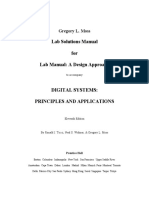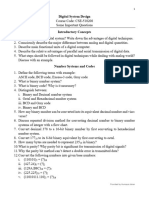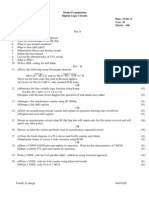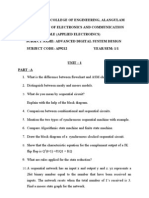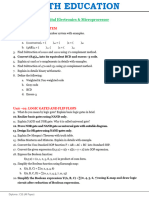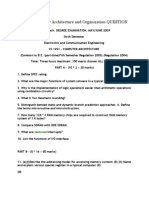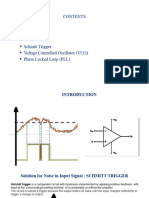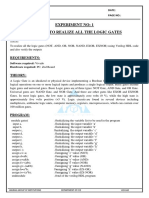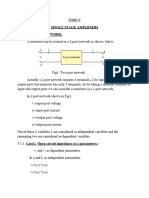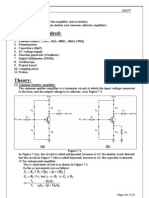Ei2353:Digital System Design: Question Bank
Ei2353:Digital System Design: Question Bank
Uploaded by
nithyadeceCopyright:
Available Formats
Ei2353:Digital System Design: Question Bank
Ei2353:Digital System Design: Question Bank
Uploaded by
nithyadeceOriginal Description:
Original Title
Copyright
Available Formats
Share this document
Did you find this document useful?
Is this content inappropriate?
Copyright:
Available Formats
Ei2353:Digital System Design: Question Bank
Ei2353:Digital System Design: Question Bank
Uploaded by
nithyadeceCopyright:
Available Formats
EI2353:DIGITAL SYSTEM DESIGN
Question Bank
UNIT I- DIGITAL LOGIC FAMILIES
PART A
1. What factors determine CMOS Fan out?
2. How is saturation delay time reduced with schottky TTL?.
3. Compare TTL, CMOS and ECL logic families with respect to power dissipation and
propagation delay.
4. List the salient features of ECL family.
5. What is the main advantage of ECL over other IC technologies? In what type of
application should ECL not be considered?
6. Which logic family performs better in a high-noise environment : CMOS or TTL? Why?
7. State the advantages of a CMOS logic family.
PART B
1. Explain the working of basic TTL NAND gate with a neat diagram. Explain the following
three types of output configurations 1)operation of open collector 2)Totem-pole 3) Tristate output.
2. Explain the transfer characteristics of CMOS gate, , 2 input NAND gate and 2 input NOR
gate.
3. Discuss on basic ECL inverter/buffer circuit, two input OR/NOR gate operation and
mention the characteristics of the ECL family.
4. Discuss in detail TTL-to-CMOS interface. Explain the features of I2L.
5. Draw the circuit of CMOS inverter and explain its operation. Also explain CMOS-toTTL interface.
UNIT II-PROGRAMABLE LOGIC DEVICES
PART A
1.
2.
3.
4.
5.
What is CPLD? List a few CPLD Devices?
What is FPGA?What type of gate is used as programmable inversion in FPGAs?
List the features of PLD .
What does CPLD stand for? How is it different from the term PLD
List two advantages of programmable logic over fixed function logic.
6. Compare FPGA and CPLD
7. Give the advantages of PAL over PLA.
PART B
1. Realize the following function using (i) PAL and (ii) PLA
F(A,B,C,D) = m(0,2,5,7,8,10,11,14)
2. (i)Implement the following function using suitable multiplexer F(A,B,C)= m(0,2,4,6)
(ii)Design a two bit up counter using D Flip Flops and implement it using suitable PAL
3. Realize the sum of product expression Y = m(0,5,10,15) using 8:1 multiplexer. Draw a
ROM circuit that produces the following outputs.
Y0 = ABC + ABC + A(BC) + ABC
Y1 = ABC + ABC + ABC and Y2 = ABC + ABC
4. Compare a ROM implementation with a PLA implementation of the circuits with output
function.
F1= (0,1,6,7)
F2 =(1,3,5,6,7)
F3 =(1,2,3)
5. (i) Explain the schematic design of programmable interconnect and basic logic element of
typical FPGA.
(ii) Write short notes on CPLD.
UNIT III- DIGITAL MEMORIES
PART A
1.
2.
3.
4.
What is a FIFO Memory?
What is the advantage of EPROM over PROM?
Compare between SRAM and DRAM.
Determine the number of inputs, the number of outputs, and the type of output for each of
the following PAL part number (a) PAL 12H6 (b) PAL 16L2
5. List different types of ROMs available and their application areas.
6. What is access and cycle time.
7. Write any four characteristics of memory.
PART B
1. What is a ROM? Draw the ROM cell and explain its operation
2. What is Memory expansion? Construct a 2K x 8 memory from 1K x 4 memories
3. Draw a basic logic diagram for a 512 x 8 bit static RAM, showing all the inputs and
outputs. Also, mention the capacity of a DRAM that has twelve address lines.
4. Give two valid differences between SRAM and DRAM. Use 16k x 8 DRAM to build 64k
x 8 DRAM, show the logic diagram
5. With a typical three-transistor DRAM cell explain the Read and write operation with
timing diagram.
6. Draw the schematic diagram of a SRAM cell array and explain its operation
UNIT IV- DIGITAL SYSTEM DESIGN CASE STUDIES
PART A
1.
2.
3.
4.
5.
6.
List the features of flash memory.
What is the basic difference between time and frequency measurement?
Mention some applications of PRBS generator.
An ADC3511 is connected with a reference voltage of +2V dc. What will be the duty
Cycle held in the counter for an analog input of 1.25V dc?
Show how to multiplex a commonanode- type display. What happen if the pulse width
is decreased in the multiplexing display?
7. Draw the block diagram of a basic frequency counter.
PART B
1. Discuss in detail about the operation of a Digital Voltmeter with neat sketch.
2. Discuss in detail on : (i) Frequency counter (8) (ii) Time measurement
3. Discuss on multiplexing displays using common-anode and common-cathode type LED
seven-segment indicator
4. With the circuit diagram explain the operation of 4-bit PRBS generator. Give the PRBS
output for continuous 16 clock cycles.
5. (i) Explain the design aspects and digital logic implementation of PRBS Generator
(ii) How are displays multiplexed and interfaced?
6. Describe the digital logic implementation of electronic frequency counter and analyze its
performance measures
UNIT V-DESIGN FOR TESTABILITY
PART A
1.
2.
3.
4.
5.
6.
Give the importance of testability measures.
When do we go for scan methods based testing?
When is a circuit said to have poor random observability?
Give the principle of scan based test techniques
Mention few electrical faults and logical faults
Define the term controllability and observability with respect to design for testing of
logic circuits.
7. What is test access port. Mention its significance
PART B
1.
2.
3.
4.
5.
Discuss in detail about board level and system DFT approaches
Discuss in detail about digital circuit testing by applying test vectors and by in-circuit
testing
Explain the following Ad Hoc Design for testability techniques (i) Test points (ii)
Initialization and (iii) Oscillators and clocks.
Discuss on scan-based technique with a suitable example
Explain in detail about various types of cross point fault that occur in PLAs and also
explain how test generation can be achieved in testing a PLA
You might also like
- Solutions Manual Digital Systems Principles Applications 11th Edition Tocci PDFDocument10 pagesSolutions Manual Digital Systems Principles Applications 11th Edition Tocci PDFTariqul Hasan0% (3)
- Deld QB EndsemDocument4 pagesDeld QB EndsemUV New MoviesNo ratings yet
- LCD Question Bank - 1Document7 pagesLCD Question Bank - 1shreyaedu27No ratings yet
- Sample Questions: Chapter One: Digital Building BlocksDocument4 pagesSample Questions: Chapter One: Digital Building BlocksDonnNo ratings yet
- LCD Question Bank - 1Document7 pagesLCD Question Bank - 1shreyaedu27No ratings yet
- Digital System Design: Provided by Humayra JahanDocument5 pagesDigital System Design: Provided by Humayra JahanZabirNo ratings yet
- EE6301 DLC Question Bank Rejinpaul 2Document8 pagesEE6301 DLC Question Bank Rejinpaul 2aruljothiNo ratings yet
- Ec2203 Digital ElectronicsDocument8 pagesEc2203 Digital ElectronicspappujayaNo ratings yet
- Question Bank: Ec6302 Digital ElectronicsDocument14 pagesQuestion Bank: Ec6302 Digital ElectronicsBarry SmithNo ratings yet
- 08.402 Digital Electronics and Logic Design (E)Document1 page08.402 Digital Electronics and Logic Design (E)anupvasuNo ratings yet
- DLCDocument1 pageDLCrjvenkiNo ratings yet
- Unit Wise Imp QuestionsDocument3 pagesUnit Wise Imp Questionsvk2you009100% (1)
- DLDM Assignment - Tutorial - QB - MCQ - (DIV B)Document21 pagesDLDM Assignment - Tutorial - QB - MCQ - (DIV B)so0071129No ratings yet
- EE6301 QB FinalDocument21 pagesEE6301 QB FinallithijanarNo ratings yet
- DSD - Assignment 1 2018Document3 pagesDSD - Assignment 1 2018Naveen KumarNo ratings yet
- QUESTIONABNK_DDCO 2024Document4 pagesQUESTIONABNK_DDCO 2024naikmeghana369No ratings yet
- 21cs33 Super Important - 21SCHEMEDocument3 pages21cs33 Super Important - 21SCHEMEGagan V hallurNo ratings yet
- Digital ElectronicsDocument7 pagesDigital ElectronicsAlakaaa PromodNo ratings yet
- MODULE - Wise Question - 2022-DdcoDocument4 pagesMODULE - Wise Question - 2022-Ddcojeevanashree2004No ratings yet
- DICSD Question BankDocument5 pagesDICSD Question Bankmunimunendra00No ratings yet
- Analog and Digital Integrated Circuit Question BankDocument12 pagesAnalog and Digital Integrated Circuit Question BankMATHANKUMAR.S67% (3)
- MODULE - Wise Question - 2022-ADE-CODocument4 pagesMODULE - Wise Question - 2022-ADE-COvinayvinayakars313No ratings yet
- Ap7202-Asic and FpgaDocument12 pagesAp7202-Asic and FpgaMOTHI.R MEC-AP/ECENo ratings yet
- DTE important questions 22320Document3 pagesDTE important questions 22320gr7226485No ratings yet
- Digital Electronics QBDocument7 pagesDigital Electronics QBvinaytmkNo ratings yet
- Digital Fundamentals BE SEM 3Document2 pagesDigital Fundamentals BE SEM 3Dhwanil BhattNo ratings yet
- DDCO QuestionsDocument6 pagesDDCO Questionsrvit24bcs412.rvitmNo ratings yet
- Question Paper Code:: Reg. No.Document3 pagesQuestion Paper Code:: Reg. No.Arun KumarNo ratings yet
- DLDM Question BankDocument8 pagesDLDM Question BankMayur PatilNo ratings yet
- QB - End - SemDocument2 pagesQB - End - SemSheetal WaghchawareNo ratings yet
- Ap9212 AdsdDocument12 pagesAp9212 AdsdKartheeswaran Arumugam33% (3)
- DTE Imp QuestionsDocument2 pagesDTE Imp QuestionsPushkar rane 1oth,B,ROLL NO.47No ratings yet
- @vtucode - In-Question bank-DD&CO-2022-schemeDocument4 pages@vtucode - In-Question bank-DD&CO-2022-schememurageshadahalli8No ratings yet
- It 2354Document1 pageIt 2354Nijin VinodNo ratings yet
- M.E Adsd Question PaperDocument2 pagesM.E Adsd Question PapershankarNo ratings yet
- DELD ImportantDocument2 pagesDELD Importantdevendratavhare6No ratings yet
- Question Bank For Mid-2 r13 (Vlsi) .Document6 pagesQuestion Bank For Mid-2 r13 (Vlsi) .rppvchNo ratings yet
- Vlsi QBDocument2 pagesVlsi QBSam Joel.DNo ratings yet
- Microcontroller Based System Design Question BankDocument2 pagesMicrocontroller Based System Design Question BankVishal KottarathilNo ratings yet
- Ec34 Question BankDocument6 pagesEc34 Question Bankkartheeswaran11No ratings yet
- Dlcao Assignment QuestionDocument3 pagesDlcao Assignment Questiontanishmanojsapate7No ratings yet
- University Question Papers - VLSIDocument26 pagesUniversity Question Papers - VLSIVijayNo ratings yet
- De & M Model QuestionsDocument4 pagesDe & M Model Questionsvishalkushwaha10203040No ratings yet
- DTE IMPQ by Campusify (1)Document5 pagesDTE IMPQ by Campusify (1)mrscollege235No ratings yet
- Question Bank For DLCDocument8 pagesQuestion Bank For DLCAvina AshNo ratings yet
- CHAPTER-1: Introduction To Microprocessor (10%) : Short Answer QuestionsDocument6 pagesCHAPTER-1: Introduction To Microprocessor (10%) : Short Answer QuestionsRAHULNo ratings yet
- Question Bank Subject: Digital Electronics and Computer Organization Subject Code: BCA - 202 (N)Document5 pagesQuestion Bank Subject: Digital Electronics and Computer Organization Subject Code: BCA - 202 (N)Nandha Kizor V100% (1)
- EC2303 Computer Architecture and Organization QUESTION PAPERDocument4 pagesEC2303 Computer Architecture and Organization QUESTION PAPERJayagopal JaiNo ratings yet
- DLD_allunits_importantDocument3 pagesDLD_allunits_importantnish630174No ratings yet
- Question BankDocument5 pagesQuestion Bankuma_saiNo ratings yet
- Bsc-II ElectronicsDocument7 pagesBsc-II Electronicskaranspawar007No ratings yet
- Deld ImpDocument2 pagesDeld Impjtrupti3007No ratings yet
- Embedded Systems 9168 - Sample Paper of MSBTE For Sixth Semester Final Year Computer Engineering Diploma (80 Marks)Document2 pagesEmbedded Systems 9168 - Sample Paper of MSBTE For Sixth Semester Final Year Computer Engineering Diploma (80 Marks)Sanjay DudaniNo ratings yet
- Model MCDocument2 pagesModel MCAkilen MahalingamNo ratings yet
- Stld Imp for 3-4-5 UniDocument1 pageStld Imp for 3-4-5 UniSiva NagendraNo ratings yet
- QB UT3portionsDocument2 pagesQB UT3portionspreethikabhaskarNo ratings yet
- Sri Venkateshwara College of EngineeringDocument3 pagesSri Venkateshwara College of EngineeringpavanNo ratings yet
- DCD Question Bank For II-I ECE (R23)Document6 pagesDCD Question Bank For II-I ECE (R23)TejaswiNo ratings yet
- Exploring BeagleBone: Tools and Techniques for Building with Embedded LinuxFrom EverandExploring BeagleBone: Tools and Techniques for Building with Embedded LinuxRating: 4 out of 5 stars4/5 (2)
- Programmable Logic Controllers: A Practical Approach to IEC 61131-3 using CoDeSysFrom EverandProgrammable Logic Controllers: A Practical Approach to IEC 61131-3 using CoDeSysNo ratings yet
- The Elements of Computing Systems, second edition: Building a Modern Computer from First PrinciplesFrom EverandThe Elements of Computing Systems, second edition: Building a Modern Computer from First PrinciplesNo ratings yet
- Department of Electronics and Communication: II B.Tech - II SemesterDocument56 pagesDepartment of Electronics and Communication: II B.Tech - II SemestersaftainpatelNo ratings yet
- Schmitt TriggerDocument18 pagesSchmitt TriggerSusmita AdhikaryNo ratings yet
- Experiment No: 1 HDL Code To Realize All The Logic Gates: Name: A.Vineela Reddy Date: HT N0.: 16H61A04C6 Page No.Document49 pagesExperiment No: 1 HDL Code To Realize All The Logic Gates: Name: A.Vineela Reddy Date: HT N0.: 16H61A04C6 Page No.Suraj AnanthulaNo ratings yet
- Amplitude ModulationDocument10 pagesAmplitude ModulationlakshmiNo ratings yet
- Kelvin Double Bridge: Made by St. 2 Stage at MITE Esra'a University CollageDocument3 pagesKelvin Double Bridge: Made by St. 2 Stage at MITE Esra'a University CollageOsama HayderNo ratings yet
- Noc21 Ee21 Assignment 1 Week 6 PDFDocument1 pageNoc21 Ee21 Assignment 1 Week 6 PDFΜάριος ΗλίαNo ratings yet
- Ovw2 EncoderDocument2 pagesOvw2 Encoderdatnt.tbd1No ratings yet
- Chapter 1 Introduction: Impedance or Oating Z Output State Results. This Is of Importance in Multiplexers, MemoryDocument1 pageChapter 1 Introduction: Impedance or Oating Z Output State Results. This Is of Importance in Multiplexers, MemoryCarlos SaavedraNo ratings yet
- The RC Oscillator CircuitDocument6 pagesThe RC Oscillator CircuitNishanthi Bheeman100% (2)
- Circuit Analysis 1Document7 pagesCircuit Analysis 1Bernard BraingixNo ratings yet
- Unit-V BJT FET AMPLIFIERSDocument36 pagesUnit-V BJT FET AMPLIFIERSDr D S Naga Malleswara RaoNo ratings yet
- DoctronicsDocument24 pagesDoctronicsMavia DahulueNo ratings yet
- Common Emitter and Common Collector AmplifiersDocument7 pagesCommon Emitter and Common Collector Amplifiersabdullah samdi89% (9)
- Rajagiri School of Engineering and Technology: Rajagiri Valley, Kakkanad. Third SemesterDocument37 pagesRajagiri School of Engineering and Technology: Rajagiri Valley, Kakkanad. Third SemesterAmrita VenkitaramaniNo ratings yet
- Digital ElectronicsDocument13 pagesDigital ElectronicsPrateek MudgilNo ratings yet
- Task 1 PDFDocument1 pageTask 1 PDFBobyCatNo ratings yet
- Interconnection Between NetworksDocument15 pagesInterconnection Between Networksthamilmaran alwarNo ratings yet
- ECE467: To Vlsi Design: Lecture-1Document27 pagesECE467: To Vlsi Design: Lecture-1Rohan JainNo ratings yet
- Upc1237 PDFDocument5 pagesUpc1237 PDFPrasannanNo ratings yet
- LC OscillatorDocument10 pagesLC Oscillatorompukkalla11No ratings yet
- COs-wise Quiz BEC151Document6 pagesCOs-wise Quiz BEC151Aman SharmaNo ratings yet
- Yaesu VX 6r Technical SupplementDocument56 pagesYaesu VX 6r Technical Supplementja3robinNo ratings yet
- FM Transceiver Project (144-148 MHZ)Document38 pagesFM Transceiver Project (144-148 MHZ)bhavya_gaddeNo ratings yet
- Sequential StaticDocument20 pagesSequential Staticvivek singhNo ratings yet
- Laches y Flip FlopsDocument38 pagesLaches y Flip FlopsFernando RamirezNo ratings yet
- Industrial IO HandbookDocument43 pagesIndustrial IO HandbookMogra BlissNo ratings yet
- Reliance Placement Paper PDFDocument6 pagesReliance Placement Paper PDFHitesh Himanshu100% (1)
- Lab Experiment 3 TE2016 V.em13Document6 pagesLab Experiment 3 TE2016 V.em13mstgofcoNo ratings yet
- Hsaf (Hybrid Series Active Filter)Document41 pagesHsaf (Hybrid Series Active Filter)adityajammula100% (3)
